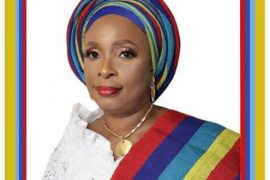Mary Ellen Iskenderian is President and CEO of Women’s World Banking, the global nonprofit devoted to giving more low-income women access to the financial tools and resources they require to achieve security and prosperity.
The Women’s World Banking reputed as the world’s largest network of microfinance institutions and banks; is being driven by one woman who found her purpose early in life and subsequently determined to work in the direction of ameliorating the suffering of people living in poverty- the indefatigable Amazon of many parts- Mary Ellen Iskenderian
Ms Iskenderian leads the Women’s World Banking efforts in 28 countries in Africa, Asia, Eastern Europe, Latin America and the Middle East; serving over 14 million women clients.
In an interview with Amazons Watch Magazine team, Ms Iskenderian highlights the groundbreaking impact of WWB efforts in transforming the lives of ordinary women.
Excerpts
AMW: Why is Women’s World Banking focused on women?
More than one billion women globally do not have access to financial services. As the majority of poor and unbanked worldwide, women face societal and infrastructure barriers that can prevent them from accessing financial services. In fact, women living on less than $2/day are 28 percent less likely to have access to a bank account.
When you invest in women you invest in the advancement of families and societies. Whether you talk to a woman in India or Paraguay, we hear the same things. Women invest in their children’s education, better healthcare for their families, and better housing. These are the types of investments that can drive long-term improvements in families and communities around the world.
And finally, when you invest in women, you are investing in stronger economic growth because women are the fastest-growing, most dynamic market segment in the world. The recent McKinsey “Power of Parity” report stated that if every country matched the rate of improvement in reaching gender parity of the fastest-improving country in their region, as much as $12 trillion in annual GDP could be added by 2025.
Despite the enormous potential that lies behind these numbers, there is a 9 percent financial inclusion gender gap in developing countries, a gap that has remained constant since 2011. This is where the work of Women’s World Banking comes in.
AMW: We would like to know some of the successes of Women’s World Banking under your leadership as President and CEO?
I am particularly proud of the work that Women’s World Banking and its partner financial institutions have done to prove the business case for providing financial products and services to low-income women. Women are excellent clients for banks and insurance companies. They have better loan repayment rates, purchase more life and health insurance, and maintain more significant long-term savings account balances than men. They are very loyal customers as well once their trust has been gained. Perhaps I am most proud of our $50 million impact investment fund, Women’s World Banking Capital Partners, which “puts our money where our mouth is” by making equity investments in women-focused financial institutions.
AMW: What are the challenges you have faced in ensuring that the sole aim of empowering low-income women is achieved?
One of the most frustrating challenges of this work is, despite decades of research showing women to be profitable and loyal clients, banks are still not investing in serving them with appropriate products and services. Financial services have traditionally been designed with the needs of men in mind without taking into account women’s preferences and uses of these services. However, Women’s World Banking’s experience shows that financial services that effectively meet women’s needs will also appeal to and promote financial inclusion for men. Designing services for women simply means ensuring universally attractive features for savings accounts, loans, insurance plans or other offerings. This approach, which is a cornerstone of Women’s World Banking’s work, does not imply the exclusion of men, nor does it imply the need for separate services for women.
There is much research to show that more diverse organizations are also more innovative. We also know that diverse teams have better problem-solving outcomes. Data from the financial institutions that comprise Women’s World Banking’s network indicates that institutions that are more diverse with more than 35 percent women board members, managers and staff have a higher Return on Assets (ROA) and serve more women clients. Looking at larger data sets, Catalyst has collected data to show that gender diversity in the workplace is associated with many positive outcomes including better financial performance and increased innovation.
However, simply hiring more women is not enough. Women need the tools to succeed as individuals and team leaders, and the skills and confidence to make their best contribution to the organization. Organizations also need to ensure that they are not inadvertently creating barriers that make it hard for women, particularly in conservative cultures, to work and progress. One way to do that is by tracking whether women are progressing up the corporate ladder and joining the ranks of senior management, both through leadership training and providing support to both genders to balance work and career.
For more than ten years Women’s World Banking has helped institutions build diverse leadership teams with the tools to navigate growth and change in their institutions while meeting the needs of low-income women. Our gender diversity assessment helps leaders evaluate how their organization is attracting, retaining and developing diverse talent. We also support in the development of a gender diversity scorecard and the implementation of strategies necessary to become an employer of choice for women.
AMW: In what ways do you think women can be more relevant in issues bothering on the improvement of economic growth?
One significant underserved market of women who are poised to contribute significantly to economic growth globally are those who are growing small and medium-size enterprises (SMEs). The International Finance Corporation estimates that approximately 65 percent of women-led SMEs in developing countries are either unserved or underserved financially. According to a recent Goldman Sachs study, closing the SME credit gap can have a tremendous impact to the global economy: if we close this gap by 2020 in just 15 countries, per capita incomes will increase 12 percent by 2030. This means that more women will have access to the financial tools they need to grow their businesses, employ others and strengthen their economic security.
Innovative uses of technology in financial services (“FinTech”) can address several key barriers women small business owners face in accessing appropriate financial services, such as high collateral requirements and transaction costs, information asymmetry, and tedious documentation processes. As an example, take Manal Hassan, a client of Women’s World Banking’s partner institution Micro fund for Women in Jordan. Manal owns a successful beauty salon. A salon is one example of a typical service-oriented, women-owned business that does not hold much physical collateral. Like many women in Jordan and other developing countries, Manal is unlikely to own the property where her business is located, and she may not even have an official form of identification.
There are several ways FinTech can help women like Manal, including offering unsecured loans using nontraditional credit scoring models (such as supply chain transactions and mobile phone usage), as well as speed and convenience, which are significant features for women business owners who have many responsibilities at work and at home.
AMW: What approaches do you think can be employed in order to improve existing processes of assisting women financially?
Digital technology has an enormous role to play in bringing access to financial services for women, especially savings. For low-income women in particular, savings accounts can be a game-changer by allowing them to build more financial security for themselves and their families, to grow their businesses, and to cope with emergencies. However, low-income women often face barriers to accessing a safe place to save due to mobility and time constraints as well as low levels of financial literacy. They are forced to save in less reliable ways: at home in a drawer or under a mattress, by buying excess stock for their businesses or through a neighbourhood savings club.
Women are far more likely to benefit from their savings accounts if they are trained to use them to their full advantage, and especially if they find their account meets their need for convenience, security, and privacy. The introduction of digital technology can satisfy these criteria through new channels such as mobile phones and retail agents.
In Malawi, Women’s World Banking partnered with NBS Bank to develop the Pafupi (meaning “close” in the local dialect, Chichewa) Savings account. It is designed for low-income women who are not using a bank either because it is too far or they don’t think a bank is meant for them. With Pafupi Savings, women can open accounts and make small deposits and withdrawals whenever they want at local shops with NBS Bank agents who transact with the bank using a mobile phone. Tools like Pafupi Savings represent a huge opportunity to close the gender gap in financial inclusion and provide a solution for women that addresses their needs.
AMW: How do you see Microfinance evolving in the next decade?
The earliest efforts to bring formal financial services to women began with microcredit small loans to small entrepreneurs. In recent years, studies show that when a woman controls her own finances, she invests in the health, nutrition, and education of her family investments that drive inter-generational change with a ripple effect in her community. At the macro level, expanding financial inclusion for women has a profound impact on overall economic growth and community development. This evidence proves that to achieve full financial inclusion today, women need financial tools that go far beyond loans
Expanding financial inclusion means ensuring that women have access to a full selection of financial products as well as the training and education to use these services well. Most importantly, these products must be designed and delivered in ways that fit into women’s lives. Banks will miss a great opportunity if they simply enable more women to access products without regard for how they will (or will not) be used.
In addition to savings, as I mentioned earlier, insurance is a pressing need for low-income women around the world. Our research shows that women typically bear the brunt of health-related costs in their families burden that often triggers a slide into poverty. Women report that their biggest challenge stems from the gap between public health coverage and the steep incidental costs related to a health episode, such as lost income while seeking treatment or caring for ill family members, transportation to and from the hospital, and meals purchased while away from home.
An example from Women’s World Banking’s insurance work is our partnership with Jordan’s Micro fund for Women (MFW) to create Caregiver, a cash benefit after hospitalization that clients can use for a range of needs: transportation to the hospital or replacement of lost revenue while their businesses have been closed. Micro fund for Women serves 97 per cent women clients and women are more likely to prioritize the care of their family above their own. The only exception is when women are pregnant. Women’s World Banking assured that the Caregiver policy covers all hospital stays related to pregnancy, a feature critical to improving maternal health outcomes.
Being a woman, what are the challenges you face in a management position?
When I took on the role of President & CEO of Women’s World Banking ten years ago, there were very real questions about the organization’s financial stability and continued relevance. I faced a range of challenges as I worked to strengthen and rejuvenate this great organization. But, perhaps, my most significant challenge can best be summarized in the phrase, “what got you here, won’t get you there.” I realized that many of the skills that had brought me success in my career up to that point would not be sufficient or appropriate to move Women’s World Banking and its various stakeholders in a different, more positive direction. I would need to learn how to inspire people to join me in my effort: in order to focus on what was truly critical for the organization, it would be essential for me to delegate responsibility to my colleagues and to ask for help. I saw that I would need to develop a more inclusive way of working, soliciting others’ views while making it clear that I was decisive and willing to make the “tough calls” when they were necessary. I realized that – much as I was working to re-invent Women’s World Banking – I would also need to re-invent myself and become a more nimble leader, willing to show my vulnerability, to ask questions and to give lots of credit to others.
AMW: What’s the best way for the readers of Amazons Watch Magazine to connect with you?
https://www.facebook.com/WomensWorldBanking
Https://www.linkedin.com/in/maryelleniskenderian




